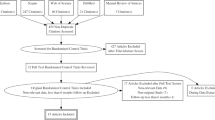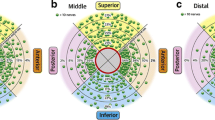Abstract
Over the past 7 years, prospective cohorts and small randomized controlled studies showed that renal denervation therapy (RDN) in patients with resistant hypertension is safe but associated with variable effects on BP which are not substantially better than medical therapy alone. The failure of the most rigorously designed randomized sham-control study, SYMPLICITY HTN-3, to meet the efficacy endpoints has raised several methodological concerns. However, recently reported studies and ongoing trials with improved procedural characteristics, identification of patients with true treatment-resistant hypertension on appropriate antihypertensive regimens further explore potential benefits of RDN. The scope of this review is to summarize evidence from currently completed studies on RDN and discuss future perspectives of RDN therapy in patients with resistant hypertension.
Similar content being viewed by others
References
Papers of particular interest, published recently, have been highlighted as: • Of importance •• Of major importance
Calhoun DA, Jones D, Textor S, Goff DC, Murphy TP, Toto RD, et al. American Heart Association Professional Education Committee. Resistant hypertension: diagnosis, evaluation, and treatment: a scientific statement from the American Heart Association Professional Education Committee of the Council for High Blood Pressure Research. Circulation. 2008;117(25):e510–26.
Wolf-Maier K, Cooper RS, Kramer H, et al. Hypertension treatment and control in 5 European countries, Canada, and the United States. Hypertension. 2004;43:10–7.
Gupta AK, Nasothimiou EG, on behalf of the ASCOT investigators, Chane CL. Baseline predictors of resistant hypertension in the Anglo-Scandinavian Cardiac Outcome Trial (ASCOT): a risk score to identify those at high-risk. J Hypertens. 2011;29:2004–13.
Cushman WC, Ford CE, Cutler JA. For the ALLHAT Collaborative Research Group success and predictors of blood pressure control in diverse North American settings: The antihypertensive and lipid-lowering and treatment to prevent heart attack trial (ALLHAT). J Clin Hypertens. 2002;4:393–404.
Persell SD. Prevalence of resistant hypertension in the United States, 2003-2008. Hypertension. 2011;57:1076–80.
Egan BM, Zhao Y, Axon RN, et al. Uncontrolled and apparent treatment resistant hypertension in the United States, 1988 to 2008. Circulation. 2011;124:1046–58.
de la Sierra A, Segura J, Banegas JR, Gorostidi M, de la Cruz JJ, Armario P, et al. Clinical features of 8295 patients with resistant hypertension classified on the basis of ambulatory blood pressure monitoring. Hypertension. 2011;57(5):898–902.
Daugherty SL, Powers JD, Magid DJ, et al. Incidence and prognosis of resistant hypertension in hypertensive patients. Circulation. 2012;125:1635–42.
Lohmeier TE, Hildebrandt DA, Warren S, et al. Recent insights into the interactions between the baroreflex and the kidneys in hypertension. Am J Physiol Regul Integr Comp Physiol. 2005;288(4):R828–36.
Stella A, Zanchetti A. Functional role of renal afferents. Physiol Rev. 1991;71:659–82.
Sakakura K, Ladich E, Cheng Q, Otsuka F, Yahagi K, Fowler DR, et al. Anatomic assessment of sympathetic peri-arterial renal nerves in man. J Am Coll Cardiol. 2014;64(7):635–43.
Smithwick RH, Thompson JE. Splanchnicectomy for essential hypertension; results in 1,266 cases. J Am Med Assoc. 1953;152(16):1501–4.
Krum H, Schlaich M, Whitbourn R, et al. Catheter-based renal sympathetic denervation for resistant hypertension: a multicentre safety and proof-of-principle cohort study. Lancet. 2009;373:1275–81.
Krum H, Schlaich MP, Böhm M, et al. Percutaneous renal denervation in patients with treatment-resistant hypertension: final 3-year report of the SYMPLICITY HTN-1 study. Lancet. 2013;383(9917):583–4.
SYMPLICITY HTN-2 Investigators. Renal sympathetic denervation in patients with treatment-resistant hypertension (the SYMPLICITY HTN-2 Trial): a randomized controlled trial. Lancet. 2010;376:1903–9.
Esler MD, Böhm M, Sievert H, et al. Catheter-based renal denervation for treatment of patients with treatment-resistant hypertension: 36 month results from the SYMPLICITY HTN-2 randomized clinical trial. Eur Heart J. 2014;35(26):1752–9. This paper summarizes the 3 year follow-up data from this trial with data similar to the initial findings.
Mahfoud F, Ukena C, Schmieder RE, et al. Ambulatory blood pressure changes after renal sympathetic denervation in patients with resistant hypertension. Circulation. 2013;128:132–40.
Bhatt DL, Kandzari DE, SYMPLICITY HTN-3 Investigators, O’Neill WW. A controlled trial of renal denervation for resistant hypertension. N Engl J Med. 2014;370:1393–401. This paper summarizes the primary results of the sham controlled trial that changed the direction of renal denervation.
Kandzari D, Bhatt D, Brar S, et al. Predictors of blood pressure response in the SYMPLICITY HTN-3 trial. Eur Heart J. 2015;36:219–27.
Tzafriri AR, Mahfoud F, Keating JH, Markham PM, Spognardi A, Wong G, et al. Innervation patterns may limit response to endovascular renal denervation. J Am Coll Cardiol. 2014;64:1079–87.
Mahfoud F, Tunev S, Ewen S, Cremers B, Ruwart J, Schulz-Jander D, et al. Impact of lesion placement on efficacy and safety of catheter-based radiofrequency renal denervation. J Am Coll Cardiol. 2015;66:1766–75. Very important paper that illustrates the difference in norepinephrine spillover comparing different procedure of denervation illustrating how that used in SYMPLICITY HTN3 was not totally adequate for denervation.
Jung O, Gechter JL, Wunder C. Resistant hypertension? Assessment of adherence by toxicological urine analysis. J Hypertens. 2013;31:766–74. Important study to illustrate how patient adherence is discordant with patients recall of taking medications.
Ewen S, Meyer MR, Cremers B, Laufs U, Helfer AG, Linz D, et al. Blood catheter based renal denervation are not related to improvements in adherence to antihypertensive drugs measured by urine/plasma toxicological analysis. Clin Res Cardiol. 2015;104:1097–105.
Fadl Elmula FE, Hoffmann P, Larstorp AC, et al. Adjusted drug treatment is superior to renal sympathetic denervation in patients with true treatment-resistant hypertension. Hypertension. 2014;63(5):991–9.
Johnson JA. Ethnic differences in cardiovascular drug response: potential contribution of pharmacogenetics. Circulation. 2008;118:1383–93.
Böhm M, Mahfoud F, Ukena C, Hoppe UC, Narkiewicz K, Negoita M, et al. First report of the Global SYMPLICITY registry on the effect of renal artery denervation in patients with uncontrolled hypertension. Hypertension. 2015;65(4):766–74. First data from renal denervation registry in Germany on patient outcomes and demographics of resistant hypertension patients having denervation procedure in Europe.
Rosa J, Widimský P, Toušek P, Petrák O, Čurila K, Waldauf P, et al. Randomized comparison of renal denervation versus intensified pharmacotherapy including spironolactone in true-resistant hypertension: six-month results from the Prague-15 study. Hypertension. 2015;65:407–13. Important study comparing use of spironolactone now considered a key drug for resistant hypertension versus denervation.
Azizi M, Sapoval M, Gosse P, Monge M, Bobrie G, Delsart P, et al. Optimum and stepped care standardised antihypertensive treatment with or without renal denervation for resistant hypertension (DENERHTN): a multicentre, open-label, randomised controlled trial. Lancet. 2015;385:1957–65. Important outcome study that complements findings of the Prague-15 Study.
Desch S, Okon T, Heinemann D, Kulle K, Röhnert K, Sonnabend M, et al. Randomized sham controlled trial of renal sympathetic denervation in mild resistant hypertension. Hypertension. 2015;65:1202–8. The study describes how denervation helps affect blood pressure in people without resistant hypertension.
Sievert H, Schofer J, Ormiston J, Hoppe UC, Meredith IT, Walters DL, et al. Renal denervation with percutaneous bipolar radiofrequency balloon catheter in patients with resistant hypertension: 6-month results from the REDUCE-HTN clinical study. Euro Interven. 2015;10:1213–20. Important complementary study to previous comparative studies to illustrate how procedural differences can affect outcome.
Kario K, Ogawa H, Okumura K, Okura T, Saito S, Ueno T, et al. SYMPLICITY HTN Japan first randomized controlled trial of catheter based renal denervation in Asian patients. Circ J. 2015;79:1222–9.
Worthley SG, Tsioufis CP, Worthley MI, et al. Safety and efficacy of a multi-electrode renal sympathetic denervation system in resistant hypertension: the EnligHTN I trial. Eur Heart J. 2013;34:2132–40.
Fadl Elmula FE, Jin Y, Yang WY, Thijs L, Lu YC, Larstorp AC. Meta-analysis of randomized controlled trials of renal denervation in treatment-resistant hypertension. Blood Press. 2015;24:263–74.
Witkowski A, Prejbisz A, Florczak E, et al. Effects of renal sympathetic denervation on blood pressure, sleep apnea course, and glycemic control in patients with resistant hypertension and sleep apnea. Hypertension. 2011;58:559–65.
Brandt MC, Mahfoud F, Reda S. Renal sympathetic denervation reduces left ventricular hypertrophy and improves cardiac function in patients with resistant hypertension. J Am Coll Cardiol. 2012;59(10):901–9.
US National Library of Medicine. ClinicalTrials.gov [online], https://clinicaltrials.gov/ct2/show/ NCT02392351.
Kandzari DE, Kario K, Mahfoud F, Cohen SA, Pilcher G, Pocock S, et al. Global Clinical Trial Program: rationale and design for studies of renal denervation in the absence (SPYRAL HTN OFF-MED) and presence (SPYRAL HTN ON-MED) of antihypertensive medications. Am Heart J. 2016;171:82–91.
Schmieder RE, Ormiston JA, Neuzil P, Starek Z, Kay P, Dawood O et al. TCT-87 non-invasive renal denervation study using externally delivered focused ultrasound in severe resistant hypertension: 1 year follow up results. JACC. 2015; 66(15_S).
Fischell TA, Ebner A, Gallo S, Ikeno F, Minarsch L, Vega F, et al. Transcatheter alcohol-mediated perivascular renal denervationwith the peregrine system: first-in-human experience. JACC Cardiovasc Interv. 2016;9(6):589–98. Very important alternative approach to denervation emulating the procedure used in animals.
Savard S, Frank M, Bobrie G, Plouin PF, Sapoval M, Azizi M. Eligibility for renal denervation in patients with resistant hypertension: when enthusiasm meets reality in real-life patients. J Am Coll Cardiol. 2012;60:2422–4.
Bakris GL, Townsend RR, Liu M, Cohen SA, D’Agostino R, Flack JM, et al. Impact of renal denervation on 24-hour ambulatory blood pressure: results from SYMPLICITY HTN-3. J Am Coll Cardiol. 2014;64(11):1071–8.
Author information
Authors and Affiliations
Corresponding author
Ethics declarations
Conflict of Interest
Alexander Briasoulis declares that he has no conflict of interest.
George L. Bakris reports non-financial support as a consultant for Vascular Dynamics, Kona, and Medtronic.
Human and Animal Rights and Informed Consent
This article does not contain any studies with human or animal subjects performed by any of the authors.
Additional information
This article is part of the Topical Collection on Hypertension
Rights and permissions
About this article
Cite this article
Briasoulis, A., Bakris, G.L. Current Status of Renal Denervation in Hypertension. Curr Cardiol Rep 18, 107 (2016). https://doi.org/10.1007/s11886-016-0781-2
Published:
DOI: https://doi.org/10.1007/s11886-016-0781-2




